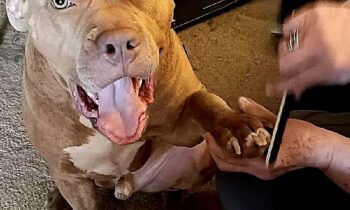
Is your pet fearful about a visit to your veterinary clinic? That’s not unusual—many pets associate veterinary visits with scary experiences that make them feel unsafe. For some animals, even the sight of the carrier in which they ride to the clinic is enough to cause them to run and hide.
The good news is that veterinarians and veterinary clinic staffs around the country are enlisting in a program that promises veterinary visits that are less stressful, less anxiety-ridden, and more pleasant for the pets they serve. This program is called Fear-Free Pets. Its motto? Taking the ‘pet’ out of ‘petrified.’
Here is the scary reality of our profession: Despite our best efforts, 37 percent of dog owners and 58 percent of cat owners say their pets hate going to the veterinarian, according to the 2014 Bayer Veterinary Healthcare Usage Study.
In addition, 26 percent of dog owners and 38 percent of cat owners report that just thinking about going to the vet is stressful.
Most patients, even the silent or seemingly happy ones, experience some level of anxiety, stress or even fear.
When they are driven to a strange-smelling building, are circled or feel cornered by other pets and people, and have strangers grab them, lift them, hold them down and stick things into places they thought were one-way only, why are we surprised that pets are stressed out?
The entire process is frightening.
Stress makes the sympathetic nervous system and the hypothalamic-pituitary-adrenal axis release multiple hormones that lead to negative physiological and metabolic changes. The fight-or-flight mechanism sometimes starts before patients leave their driveway.
—Phil Zeltzman, DVM, DACVS, CVJ
Originally published in the September 2015 issue of Veterinary Practice News
Dr. Marty Becker is often called “America’s Veterinarian.” He lives in nearby Idaho, where he practices at the North Idaho Animal Hospital in Sandpoint. He is a graduate of Washington State University’s College of Veterinary Medicine, where he is an adjunct professor. Dr. Becker is the founder of Fear Free—an initiative to “take the ‘pet’ out of ‘petrified’”—and get pets back for veterinary visits by promoting a considerate approach and gentle control techniques used in calming environments. The program now offers certification for veterinary professionals.
“The truth is, once a pet has been frightened, it never forgets that experience.”
—Dr. Marty Becker

Photo by Nan Arthur
A paradigm shift is happening in veterinary medicine. Although the physical aspects of care will always be at the forefront, the emotional well-being of animals is now recognized as an important contributor to good health. Reducing pet stress, anxiety, and fear associated with visits to the veterinary clinic has spurred the embrace of the Fear Free Initiative. At the center of the initiative is the realization that fear leads to permanent changes in the brain, specifically the region of the amygdala. This means that a puppy or kitten’s first experiences with a veterinarian stays with it for life. Therefore, while examinations require contact that may not be entirely pleasant, there is much that can be done to reduce the risk of a fear response. By employing techniques that reduce stress, the cortex can override the amygdala, which can lead even older animals that are fearful from previous experiences to learn that the veterinary clinic is a good place.
—Meredith Rogers, MS, CMPP
The major goal of the eight-module online course, which concludes with a test, is to teach veterinarians and clinic staff to identify signs of fear in pets and to reduce or remove anxiety triggers in the hospital environment.
“You’re trained in veterinary school to find things [physically] wrong,” Becker said.
“Fear was like a disease we didn’t know existed, or we thought of it like the common cold.
“With Fear Free, all you’re doing now is looking at physical well-being and emotional well-being. You’re looking at and caring about both.”
Certification participants learn how to reduce or prevent stress in the clinic environment. Tactics include using scents like pheromones—especially for cats—playing relaxing music, warming the exam table, examining the pet on a mat on the ground, rewarding with treats, and utilizing mild sedation and analgesics for potentially painful or scary procedures.
Combined, all the techniques, protocols, and products work to reduce fear, anxiety, and stress, which leads to a more cooperative patient and safer and more efficient treatment, Becker said. As a result, veterinarians should see stronger client relationships and increased client retention and patient visits.
https://www.veterinarypracticenews.com/why-you-should-fight-pet-fright-with-fear-free-vet-practices/
Here’s a short video about Fear Free veterinary practices:
Fear Free: A Transformative Initiative for Veterinary Professionals
https://www.youtube.com/watch?v=tT55oYtVNfk
This is a link to a very comprehensive article about the fundamentals of a Fear Free veterinary visit, with many suggestions on how pet owners can be a critical part of the process:
https://www.aaha.org/pet_owner/lifestyle/the-fundamentals-of-a-fear-free-veterinary-visit.aspx
Here is another short video from Fear Free for pet owners:
Fear Free: How Pet Owners Can Enjoy Veterinary Visits With Their Pets
https://www.youtube.com/watch?v=bpPzqWS2Mo0
This is a link to a directory of fear-free certified professionals that you can search by ZIP Code:
Dr. Becker, with co-authors Lisa Radosta (a veterinary behaviorist), Mikkel Becker (a pet trainer), and Wailiani Sung (a veterinary behaviorist), has written a newly published book on the Fear Free initiative and how its principles can work for your pet dog—From Fearful to Fear Free: A Positive Program to Free Your Dog from Anxiety, Fears, and Phobias.
Almost every dog owner has a pet who suffers from fear, anxiety, and stress (FAS). They are the underlying cause of many concerning behaviors such as excessive barking, aggression, destructive behaviors, and house-soiling. They are also the source for deterioration of the human-animal bond, and can make a trip to the veterinarian, pet groomer, or boarding facility miserable for pet and owner alike. Left untreated, these negative experiences can lead to devastating consequences and permanent damage. Unfortunately, many well-meaning owners misinterpret or overlook the often subtle signs of emotional injury and turmoil, or think that the pet will simply “outgrow” it. This leads to unnecessary trauma and suffering.
Common FAS triggers include:
▪ Trips to the veterinarian (even for routine services such as vaccinations and nail trims)
▪ Bath time, brushing, or cleaning ears
▪ Loud noises; thunderstorms; fireworks; the vacuum cleaner; construction; gunshots; or even buzzers on appliances
▪ Less-familiar people or animals encountered on walks or near the home
▪ Being left alone during work hours or even for short errands
▪ Travel, including car rides
Finally, there’s help. From Fearful to Fear Free is based on the groundbreaking Fear Free program embraced by tens of thousands of veterinary healthcare professionals and hundreds of thousands of pet owners (fearfreepets.com and fearfreehappyhomes.com). This is the first and most authoritative book on the subject of reducing FAS and increasing “happy and calm” in dogs. Since pets communicate nonverbally, this book will help you recognize if your pet is suffering from FAS. By knowing your dog’s body language, vocalizations, and changes in normal habits, you can make an accurate diagnosis and take action to prevent triggers or treat the fallout if they do happen.
You’ll learn:
▪ The most effective prescription sedatives for keeping dogs calm and happy during thunderstorms, fireworks, and other stressful events
▪ The positive steps you can take to keep your pet occupied, calm, and content while you’re away at work or play
▪ Simple, practical tactics for helping your dog learn to love going to the veterinarian’s office―literally pulling you into the practice instead of avoiding it!
▪ How to easily groom your dog and give him medication
▪ Tips to tame the chaos when guests arrive in your home or when your dog encounters other dogs and people on walks
▪ Ways to tackle some of the common behavior issues that often have a root cause of FAS, while also improving your communication and bond with your pet
https://www.amazon.com/Fearful-Fear-Free-Positive-Program/dp/0757320791



